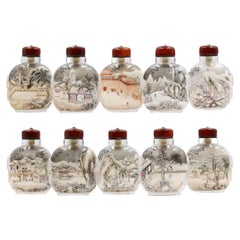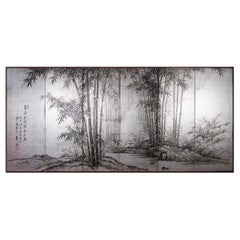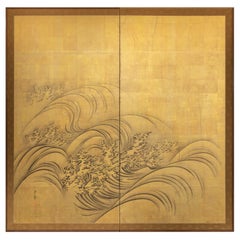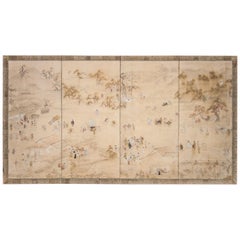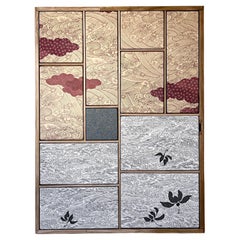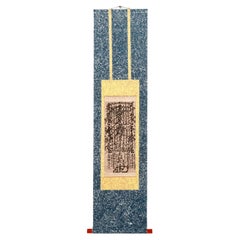East Asian Paintings and Screens
to
261
828
268
1,329
85
8
35
13
11
4
2
1
1
149
556
624
93
243
112
61
35
4
28
12
3
8
17
18
7
2
625
609
560
502
401
1,593
1,422
926
442
131
1,422
1,383
1,396
29
4
3
2
2
Place of Origin: East Asian
Inside Painted Snuff Bottles, Ten Pieces Snow Landscapes by Sun Sansong 1999
Located in Tainan, TW
Sun Sansong is the very early student of Wang Xisan. This collection is very rare and worth collecting. Ten Pieces are all his "FINE" works.
Artist: Sun ...
Category
20th Century Modern East Asian Paintings and Screens
Materials
Glass
Japanese Six Panel Screen Bamboo Forest in Kyoto
Located in Hudson, NY
Ink painting of bamboo on nicely patinated silver leaf. Dated 1919, Signature reads: Seikoku.
Category
Early 20th Century East Asian Paintings and Screens
Materials
Paper
Japanese Two Panel Screen: Waves on Gold
Located in Hudson, NY
Ink on gold leaf with a silk brocade border. Signature reads: Nakajima Raishou (1796-1872). Student of Maruyama Okyo (one of Japan's most famous artists).
Category
Mid-19th Century Antique East Asian Paintings and Screens
Materials
Brocade, Silk, Paper
Japanese Four Panel Screen Country Genre Scene
Located in Hudson, NY
Depicting farmers, pheasant hunting, picnicking, festival and general village scenes. Ink and mineral pigments on handmade mulberry paper.
Category
18th Century Antique East Asian Paintings and Screens
Materials
Paper
Antique kimono textile art " Waves and clouds ~Eternity~ " by ikasu Beige, Japan
By Kimono ikasu
Located in Setagaya City, JP
This work is inspired by traditional hand-dying technique edo-komon, and is framed in paulownia wood originally used for a kimono chest-of-drawers.
It is elegantly framed with paulo...
Category
1920s Japonisme Vintage East Asian Paintings and Screens
Materials
Silk, Wood
Early Japanese Gohonzon Buddhist Calligraphy Mandala Scroll Edo Period
Located in Atlanta, GA
A Japanese sumi ink calligraphy Buddhist mandala mounted as a paper hanging scroll known as Kakejiku or sometimes Moji mandala. Termed as gohonzon in Japanese, it is a venerated object within Nichiren Buddhism (Hokkeshu; lotus sect). The originally concept was developed by the 13th century Buddhist priest Nichiren to guide the energy of the devotional chanting to...
Category
1810s Edo Antique East Asian Paintings and Screens
Materials
Paper
B3 Japanese Antiques, Reeds and geese, silver folding screens set, ink, by Shoko
Located in Niiza, JP
The material is silver paper.
Unfolded size: 3760 x 1180 mm
Folded size: 470 x 1180 x 105 mm, 7 kg per piece
Estimated size after packaging (sandwiched between 5 mm plywood): 35 CM x...
Category
19th Century Antique East Asian Paintings and Screens
Materials
Paper
Framed Japanese Portrait of a Buddhist Priest by Goro Kamenaga
Located in Atlanta, GA
A gouache on silk painting of a Buddhist priest by Japanese painter Goro Kamenaga (1890-1955). The highly realistic painting depicts a figure in seate...
Category
1910s Meiji Vintage East Asian Paintings and Screens
Materials
Silk
Set of 6 Large Kakemonos Japanese Mythology, 19th Century Japan circa 1800 Edo
Located in Beuzevillette, FR
Beautiful set of 6 large kakemonos from 19th century Japanese mythology.
Paper support with a canvas pasted on the paper
Wonderful set that is part of Japan's history and beliefs
When not hung, the Kakemonos are rolled up.
circa 1800 - Japan - Edo Period
A kakemono translates as "object to hang". In Japan this refers to a painting or calligraphy, most often done on silk or paper framed in a scroll that was intended to be hung on walls or in public lighting. This particular form, which allows them to be in a roll, dates back to the Tang dynasty in China (this would be related to the copying and preservation of ancient Buddhist texts). A Kami is a deity or spirit worshipped in the Shinto religion. A Yokai is a spirit, ghost, demon, or strange apparition from the creatures of Japanese folklore.
Each of these kakemonos represents a unique story:
- A kami, a Japanese deity, is shown painting a rainbow. Indeed, he performs the action with his right hand while his left hand holds a kind of basket with three pots of paint. This kami has a rather closed attitude. He is standing in a dark and tormented sky. Below this figure, 8 villagers are dressed in traditional Japanese clothes. Their faces are softened. They are not afraid of the elements made by the kami above their heads.
- A character with an unreal look is holding a kind of jar with his two hands, which he spills on human figures above. This being is floating in the air, probably a character from mythology, perhaps Susanoo. Underneath, villagers on umbrellas. They are trying to protect themselves as best they can from what is falling on them. One of them is carrying baskets with fish on her shoulders. A character in the background is thrown forward and falls.
- On this kakemono, the god Raijin, dressed in a white and blue outfit, strikes the sky with his two drum hammers to create lightning and its thunderous sound. Surrounded by Tomoe and a long red scarf, Raijin, enraged and with dishevelled hair, creates a dark and violent storm. The villagers seem frightened by this meteorological phenomenon. One of the villagers can be seen fainting in the arms of a man. This scene may seem chaotic, but Japanese legend tells us that once a field is struck by lightning, the harvest is good.
- On this kakemono, we see an unreal-looking figure holding a fan, as if he were sweeping away the bad weather, or simply producing gusts of wind. He is probably the kami of wind and air, Shina tsu-hiko. The figures below him seem surprised by so much wind. An umbrella flies away on the left, the women hold their hair and scarf, the clothes are caught in the power of the wind, there is even a woman on the ground on the bottom left.
- This Kakemono represents a short moment. This Raiju is a yokai (ghost spirit...
Category
19th Century Edo Antique East Asian Paintings and Screens
Materials
Paper
Japanese Two Panel Screen Plain Mulberry Paper
Located in Hudson, NY
(no image) on lattice frame. Pair available; Sold seperately.
Category
Mid-20th Century East Asian Paintings and Screens
Materials
Paper
Japanese Six Panel Screen, Egrets in Water Landscape with Lotus and Loquats
Located in Hudson, NY
Hasegawa School painting in ink and gold dust accents on mulberry paper.
Category
Mid-19th Century Antique East Asian Paintings and Screens
Materials
Gold
Japanese Two-Panel Screen Peony and Cherry
Located in Hudson, NY
Japanese two-panel screen: Peony and Cherry, Edo period (circa 1800) painting, formerly fusuma (Japanese sliding doors), executed in the Kano school style, featuring a cherry tree in...
Category
Early 1800s Edo Antique East Asian Paintings and Screens
Materials
Gold Leaf
Chinese Floral Longevity Canopy Painting, c. 1900
Located in Chicago, IL
Thoughts of a long, happy life greeted the young couple who gazed up from their bed on this canopy panel. Adorned with chrysanthemums and peaches, both symbols of longevity, the lyri...
Category
Early 20th Century Qing East Asian Paintings and Screens
Materials
Pine, Paint
Pair of Japanese Six Panel Screens: Floral Landscape / Mother with Young
Located in Hudson, NY
The first screen is depicting a mother watching her young frolicking under pine tree by river's edge, the second, a mother and her young playing under a ...
Category
Late 18th Century Antique East Asian Paintings and Screens
Materials
Gold Leaf
Lavish 19th Century Maruyama School Peacock Screen
Located in Fukuoka, JP
Lavish 19th Century Maruyama School Peacock Screen
Period: 19th Century
Size: 360 x 173 cm (141.7 x 68.1 inches)
SKU: PF12
Behold the grandeur of the ...
Category
19th Century Edo Antique East Asian Paintings and Screens
Materials
Wood, Paper
Japanese Two Panel Screen: Moon and Flowers
Located in Hudson, NY
Showa period (1926 - 1989) painting with a strong design of exotic lilies and a cluster of nadeshiko (dianthus) under a silver moon on gold. This painting has a modern flair, which ...
Category
20th Century East Asian Paintings and Screens
Materials
Silver
Vintage kimono textile art " Turquoise Forest ~Strength~ " by ikasu Blue, Japan
By Kimono ikasu
Located in Setagaya City, JP
Fabrics featuring iconic Japanese plants like chrysanthemum, maple, and bamboo were gathered from various long underwear and kimono pieces to create a set of canvases (diameter 30, 25 and 20cm) showcasing exquisite gradations.
The top canvas, in pristine white, originates from long under-kimono, while the middle and bottom canvases are skillfully upcycled from kimono fabrics.
<< Period / Story >>
The long under-kimono and kimono fabrics used in these canvases were originally crafted and worn during the late Showa period (1960-80ies).
<< Explanation and meaning of pattern and colors >>
The pattern on the top canvas features a chrysanthemum, an auspicious emblem symbolizing longevity. It is affectionately referred to as the "raccoon dog chrysanthemum" due to the large, overlapping petals resembling the fur of a muzina, a creature similar to a raccoon dog or badger. This motif is highly popular in various plant-inspired designs and frequently seen in Edo komon, katazome, and jimon textiles.
The top canvas naga-juban under-kimono, being entirely white and devoid of any additional dyes, suggests its use as formal wear. Its pristine white hue accentuates the silk's luster when exposed to light and highlights the beauty of the woven patterns.
The fabric used here is rinzu, a type of fabric thinner than crepe de chine, characterized by its soft, smooth texture and subtle sheen. This particular lintel distinguishes itself with the way its ground pattern emerges and also incorporates a woven chrysanthemum pattern.
The central canvas showcases a maple tree, symbolizing longevity, which changes its colors with the seasons, bringing joy and happiness to people's lives.
The bamboo featured on the lower canvas has been regarded as a symbol of good fortune since ancient times, given its straight and vigorous growth, along with the Chinese legend that a phoenix consumes its fruit. It embodies concepts such as "immortality," "longevity," and "strength" because it remains green even in winter. The hollow stem also signifies "innocence," suggesting that there are no hidden agendas.
All three canvases are adorned with ground patterns that, when viewed from a distance, appear as modern works of art, yet upon closer inspection, they reveal a distinct Japanese ambiance.
<< Characteristics of the fabric >>
All three canvases are made of fabrics with jimon. The unique and high level of Japanese weaving...
Category
1970s Japonisme Vintage East Asian Paintings and Screens
Materials
Canvas, Silk
Antique 19th Century Chinese Silk Embroidery "Ancestors" Panel.
Located in New Orleans, LA
Antique 19th Century Chinese Silk Embroidery "Ancestors" Panel.
Category
Late 19th Century Antique East Asian Paintings and Screens
Materials
Silk
Japanese Six-Panel Screen "Mother and Her Kittens"
Located in Hudson, NY
Japanese six-panel screen: Mother and her kittens under flowering cherry tree.
Kano School painting, mineral pigments on gold, with beautiful early bronze mounts.
Category
Late 18th Century Antique East Asian Paintings and Screens
Materials
Gold Leaf
Japanese Antiques Ink painting of a landscape, paper sliding doors, set of 4
Located in Niiza, JP
Ink Painting on Paper, Paper is pasted on the sliding door.
Size: 905 (W) x 1695 (H) x 32 (D) [mm] *Size of one piece 5kg/per
Packing size: 18 CM × 98 CM × 190 CM 40 KG
A traditiona...
Category
19th Century Antique East Asian Paintings and Screens
Materials
Paper
Japanese Six-Panel Screen Plovers in Flight Over Coastal Landscape
Located in Hudson, NY
Japanese six-panel screen: Plovers in flight over coastal landscape. Late Edo - Early Meiji period, circa 1870, painting of plovers flying over cresting waves. Sumi ink on mulberry p...
Category
1870s Antique East Asian Paintings and Screens
Materials
Silk, Wood, Paper
Japanese Six Panel Screen: Snow Scene
Located in Hudson, NY
Kano school painting of a pheasant in a snowy pine. Artist signature reads: Hokkyo Shunyo. Mineral pigments on gold leaf with silk brocade border.
Category
Early 19th Century Antique East Asian Paintings and Screens
Materials
Gold Leaf
Japanese Two Panel Screen Summer Garden on Silver
Located in Hudson, NY
Flowers including peonies, dahlias, irises, and bellflowers bloom underneath a blossoming cherry tree and provide cover for a pair of quail. The structure of this garden almost resem...
Category
Early 20th Century East Asian Paintings and Screens
Materials
Silver Leaf
Japanese Two Panel Screen: Antique Kimono Fabric Mounted on Screen
Located in Hudson, NY
Japanese Two Panel Screen: Late Nineteenth Century Kimono Fabric Mounted on Early Twentieth Century Screen. In the Heian period (eighth century to the twelfth century), noblemen wou...
Category
Early 20th Century Meiji East Asian Paintings and Screens
Materials
Silk, Wood, Paper
Japanese Six Panel Screen: Scenes in and Around Kyoto, 'Rakuchu Rakugai-Zu'
Located in Hudson, NY
The left two panels is the intersection of the Tokaido (an important and historical road that connects Kyoto with Tokyo) at Sanjo (Sanjo translates to "Third Street" and is the main ...
Category
18th Century Antique East Asian Paintings and Screens
Materials
Gold Leaf
Japanese Two Panel Screen Suiboku Landscape in Sesshu Style
Located in Hudson, NY
Suiboku is a style of ink painting that is reminicent of the way calligraphers paint. Masterfully painted Muromachi Period (1336-1573) painting, unique in style and strength for the period with very bold lines. Sesshu Toyo...
Category
16th Century Antique East Asian Paintings and Screens
Materials
Silk, Paper
Japanese Two Panel Screen: Mu (Nothing)
Located in Hudson, NY
Calligraphy reads: Mu (Nothing). Ink on silver in a black lacquered wooden trim. Seal is illegible.
Category
Early 20th Century East Asian Paintings and Screens
Materials
Silver
Vintage kimono textile art "Snowflake ~New Beginnings~" by ikasu Purple, Japan
By Kimono ikasu
Located in Setagaya City, JP
Six canvases (Diameter approx. 30cm, 25cm, 20cm) use the fabric taken from antique kimono, its' various parts, to create one harmonious fluid image of a snowflake - a symbol of new b...
Category
1970s Japonisme Vintage East Asian Paintings and Screens
Materials
Canvas, Silk
A Japanese painting depicting two European generals
Located in Amsterdam, NL
Nagasaki, 19th century
H. 98 x W. 41 cm
Provenance:
Private collection, Portugal
Category
19th Century Antique East Asian Paintings and Screens
Materials
Paper
Japanese Two-Panel Screen Pink and White Magnolias in Early Bloom
Located in Hudson, NY
Japanese two-panel screen: Pink and white magnolias in early bloom, Taisho period (1912-1926) painting of Japanese magnolia tree branches as the flowers...
Category
1920s Taisho Vintage East Asian Paintings and Screens
Materials
Silk, Wood, Paper
VIntage kimono textile art " Wish for prosperity " by ikasu Gold, Black, Japan
By Kimono ikasu
Located in Setagaya City, JP
This work is inspired by traditional Japanese nature colors symbolism, and is framed in paulownia wood originally used for a kimono chest-of-drawers.
It is filled with storytelling ...
Category
1960s Japonisme Vintage East Asian Paintings and Screens
Materials
Silk, Wood
Early 20th c. scroll depicting birds flying over the waves
Located in Fukuoka, JP
Unique signed Hanging Scroll depicting birds flying over the waves.
Age: First half of the 20th century
Size: Overall 203/64.5cm ( 79.8 / 25.3inch ) , only painting part:117/50....
Category
Early 20th Century Taisho East Asian Paintings and Screens
Materials
Wood, Paper
China "Seaside & Mountains" Landscape "Painting"
Located in South Burlington, VT
Chinese extraordinary natural stone "Painting" & with custom hardwood frame
Sea and Mountains in one unique work of art
This Chinese extraordinary natural stone "painting" of a mountain range in white and gray colors is called a dream stone Shih-hua. They are cut from historic Dali marble found in the Cangshan mountains of western China. These mysterious mountains, unique in the world, are known for yielding incredible and fantastic natural landscaped works of art created over tens of millions of years from mineral inclusions that affected the process of ancient organic material which transformed into limestone and finally resulted in marble- a metamorphic hard stone.
This art form is centuries of years old since the Ming dynasty. Dream stones became favored art in the west particularly since the 19th century when French collectors named them Pierres de reve.
This thin marble stone "painting" is approximately 1/4" thick and is cut from a large slab of rough material revealing incredible patterns in soft white and gray colors. Its weight is surprisingly modest- easily hung with standard hardware.
On occasion, private collectors would invite an artisan to inscribe a poetic description onto their more important dream stones and in this case the artists' seal mark and calligraphy translation reads:
Dimensions:
Frame: 16.5 inches high and 29 inches wide.
Site: 12.75 inches high and 25 inches wide.
Provenance: Private Chinese collection, Yunnan, China.
History of "White and Gray" dream stone paintings:
“White and Gray” dream stone paintings known in China as Shui Mo or Chinese painting stone...
Category
Late 20th Century East Asian Paintings and Screens
Materials
Marble
$2,800 Sale Price
20% Off
Japanese Six Panel Screen Mother Cat and Kittens Near Rushing Stream
Located in Hudson, NY
Kano School painting, in mineral pigments and gold leaf on mulberry paper with a silk brocade border. Artist seal reads: Hokkyo Unsen.
Category
Early 19th Century Antique East Asian Paintings and Screens
Materials
Gold Leaf
Vintage kimono textile art "On Coral Waves ~Everlasting~" by ikasu Pink, Japan
By Kimono ikasu
Located in Setagaya City, JP
<< About this canvas >>
This kimono canvas set of three pieces portrays mountains surrounded by the sea. While each of the three pieces is crafted from different kimonos, they all s...
Category
1970s Japonisme Vintage East Asian Paintings and Screens
Materials
Silk, Canvas
Japanese Two Panel Screen: Country Farm
Located in Hudson, NY
Unusual subject matter of a rural farm setting with grasses and pine in mineral pigments on paper with silk brocade border and black lacquer trim with bronze hardware. Signature and...
Category
Early 20th Century East Asian Paintings and Screens
Materials
Bronze
Japanese Painting Depicting Commodore Perry’s Ship with Buddhist Monks Aboard
Located in Amsterdam, NL
A Japanese painting depicting Commodore Matthew Perry’s flagship USS Mississippi bringing the coffin with the remains of US marine private Robert Williams who died while serving on t...
Category
Mid-19th Century Edo Antique East Asian Paintings and Screens
Materials
Paint, Paper
Vintage kimono textile art " Plum Gradation " by ikasu Pink, White, Japan
By Kimono ikasu
Located in Setagaya City, JP
This canvas featuring a plum color gradient kimono showcases a unique decorative variation of the popular seigaiha (青海波) sea waves pattern.
The artwork got a Mr. & Mrs. Abe Arts & Cu...
Category
1980s Japonisme Vintage East Asian Paintings and Screens
Materials
Canvas, Silk
Pair of Two Panel Japanese Screens: Mountain Landscape with Waterfalls and River
Located in Hudson, NY
Rivers of mist, falling water and moss draped trees evolve into a mystical landscape. Ink on silk, bordered in fine mulberry paper. Sold as a pair.
Category
Late 19th Century Antique East Asian Paintings and Screens
Materials
Silk
Japanese Six-Panel Screen Women of the Court in the Garden
Located in Hudson, NY
Japanese six-panel screen: Women of the Court in the Garden. Edo period (circa 1700) painting of an early Kano school subject matter: nobility socializing in a coutryard garden. Deta...
Category
Early 1700s Edo Antique East Asian Paintings and Screens
Materials
Gold Leaf
Antique Chinese Carved Teak Wood and Mother Of Pearl Table Screen, Circa 1890.
Located in New Orleans, LA
Antique Chinese Carved Teak Wood and Mother Of Pearl Table Screen, Circa 1890.
Category
Late 19th Century Antique East Asian Paintings and Screens
Materials
Teak, Mother-of-Pearl
Japanese Two Panel Screen: Irises Along a Raised Garden Walkway
Located in Hudson, NY
Furosaki (tea ceremony screen) Mineral pigments on mulberry paper with oxblood lacquer trim. Signature and seal read: Katsutoshi. On back it is titled: Irises (Kakitsubata) with a ...
Category
Early 20th Century East Asian Paintings and Screens
Materials
Lacquer, Paper
18th Century Japanese Two-Panel Screen Collection of Fans on Gold
Located in Hudson, NY
18th century Japanese Screen of a Collection of Fans. Paintings on fans depict famous Japanese painting subjects, this screen was most li...
Category
18th Century Edo Antique East Asian Paintings and Screens
Materials
Gold Leaf
Pair of Antique Carved Stone Panels, Japanese, Decorative, Figures, Victorian
Located in Hele, Devon, GB
This is a pair of antique carved stone panels. A Japanese, lacquered decorative scene with female figures, dating to the late Victorian period, circ...
Category
Late 19th Century Japonisme Antique East Asian Paintings and Screens
Materials
Stone
Japanese Six-Panel Screen, Chrysanthemums and Twig Fence With Gold Flakes
Located in Hudson, NY
Rimpa School painting in mineral pigments with gofun and gold flakes on mulberry paper with a silk brocade border.
Category
19th Century Antique East Asian Paintings and Screens
Materials
Gold
19th Century Pair Qing Dynasty Reverse Painted Mirrors
Located in Dublin 8, IE
19th Century Pair Qing Dynasty Reverse Painted Mirrors depicting Court Scenes. Featuring Royal Figures and their servants and advisors. All wearing colourful traditional garments. A ...
Category
19th Century Qing Antique East Asian Paintings and Screens
Materials
Glass, Mirror, Paint
Japanese Two Panel Screen: Bamboo Grove on Mulberry Paper with Gold Dust
Located in Hudson, NY
Kano School painting of a bamboo grove with blooming flowers and gold dust mists. Painted in mineral pigments on mulberry paper with gold dust and a silk brocade border.
Category
Early 19th Century Edo Antique East Asian Paintings and Screens
Materials
Gold
Antique Japanese Ink Hanging Scroll Hidaka Tetsuo with Wood Storage Box
By Hidaka Tetsuo
Located in Atlanta, GA
A hanging ink (Sumi-e) silk scroll by Japanese Zen artist Hidaka Tetsuo (1791-1871). Well presented in brocade boarders and mounted on paperback, this scroll depicts "Three Noble Friends in Winter" in a poetic and novel way. One of the favorite subjects by Chinese painters, the three noble friends in winter consists of pine, bamboo and plum flowers. They were admired for their characters of strength in cold resistance to remain evergreen and even blossom in unfavorable condition. The artist, however, composited the subjects in a none-conventional way as Ikebana. Bamboo and flowering plum branches were presented in an oversized pot...
Category
19th Century Japonisme Antique East Asian Paintings and Screens
Materials
Brocade, Wood, Paper
Japanese Two-Panel Screen Peony, Wisteria, Cherry and Bamboo on Soft Silver
Located in Hudson, NY
Japanese two-panel screen: Peony, Wisteria, cherry and bamboo on soft silver, Meiji period (1868-1912) painting of a garden in spring. Painted in mineral pigments on oxidized silver ...
Category
Early 1900s Meiji Antique East Asian Paintings and Screens
Materials
Silver Leaf
Chinese Hanging Scroll Painting of a Winter Landscape
Located in Chicago, IL
Brushed with expressive linework and a minimalist color palette, this Chinese hanging scroll painting depicts an idyllic mountainside landscape in the ...
Category
20th Century Qing East Asian Paintings and Screens
Materials
Paper, Silk
Landscape Ⅲ by Blue Tip Atelier
Located in Sammu-shi, Chiba
Title : Landscape III
Japan / 2024s
Size : W 560 H 680mm
The night sky and sea are expressed with two-tone dyed colors.
Abstract embroidery of a bird flapping its wings is applied ...
Category
2010s Modern East Asian Paintings and Screens
Materials
Linen
Japanese Two-Panel Screen Temples Through Misty Forest
Located in Hudson, NY
Japanese two-panel screen: Temples Through Misty Forest. Chinese School landscape ink painting on gilded silk by Yukimatsu Shunpo, signed and dated 1924. Yukimatsu Shunpo was born in...
Category
1920s Taisho Vintage East Asian Paintings and Screens
Materials
Silk, Wood
Japanese Two Panel Screen Nara Deer in Gentle Yoshino Landscape
Located in Hudson, NY
Japanese two panel screen: Nara Deer in Gentle Yoshino Landscape. Yoshino is in the Nara Prefecture, an area famous for these small and tame deer native to J...
Category
Early 1900s Meiji Antique East Asian Paintings and Screens
Materials
Gold Leaf, Silver Leaf
Japanese Screen Painting of Stallions
Located in Hudson, NY
Japanese two panel screen: Painting of stallions.
Kano school of painting.
Mineral pigments on mulberry paper.
Category
19th Century Antique East Asian Paintings and Screens
Vintage kimono textile art "Flowers ~Life Circle~" by ikasu Pink, Black, Japan
By Kimono ikasu
Located in Setagaya City, JP
<< About this canvas >>
This canvas is crafted from three different haori fabrics, each adorned with a shibori dyeing flower motif going through entire fabric. These fabrics tell a ...
Category
1970s Japonisme Vintage East Asian Paintings and Screens
Materials
Canvas, Silk
Japanese Two Panel Screen, Ink Landscape on Paper with Gold Dust
Located in Hudson, NY
Sesshu-style painting in ink on mulberry paper with gold dust accents and a silk brocade border.
Category
19th Century Antique East Asian Paintings and Screens
Materials
Gold
A Chinese export reverse-glass painting after an English print in original frame
Located in Amsterdam, NL
Canton, late 18th century
In original hardwood frame with ruyi-shaped metal mount for suspension.
H. 38.7 x W. 44.3 cm (incl. frame)
H. 31.8 x W. 37.5 cm (image)
Chinese reverse glass paintings for export are known since mid 18th century. By the 1780's the copying of European, mainly English, engravings came into vogue in Chinese paintings on glass...
Category
Late 18th Century Chinese Export Antique East Asian Paintings and Screens
Materials
Glass, Hardwood
Japanese Two-Panel Screen, Pine, Cherry, and Maple
Located in Hudson, NY
Cherry blossoms and maples among ragged pines. Mineral pigments on mulberry paper with gold mist clouds. Completely remounted utilizing an antique silk brocade...
Category
Mid-19th Century Antique East Asian Paintings and Screens
Materials
Gold, Bronze
Pair of Japanese Screens
Located in Schellebelle, BE
Exceptional pair of Japanese screens, 20th century
Six parts, six times 45 cm wide
Gold spotted paper with parts of old screens.
Category
Mid-20th Century East Asian Paintings and Screens
Materials
Paper
$6,518 / set
Japanese Two Panel Screen, Cherry Blossoms Viewing Party
Located in Hudson, NY
A private viewing in picnic surrounding of nobles (probably samurai), including one woman. Mineral pigments on mulberry paper with silk brocade border.
Category
18th Century Edo Antique East Asian Paintings and Screens
Materials
Silk, Paper
Recently Viewed
View AllMore Ways To Browse
Japanese Red Lacquer Frame
Lattice Panel Wood
Hanging Japanese Screen
Japanese Lattice
Japanese 19th Century Meiji Period Silk Painting
Japanese Buddhist Screen
Japanese Carved Screen
Japanese Screens And Doors
Monkey Screen
Japanese Autumn Screen
Japanese Screens Six Fold
Japanese Wood Room Divider
Kyoto Silk Painting
Japanese Dragon Painting
Japanese Birds Painted On Silk
Heian Period
Japanese Crane Panel
Japanese Divider Screen
